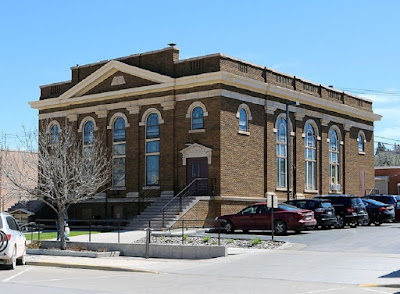Railroad
Town Hub City and Main Street Commercial Development
Since its founding in 1881, Aberdeen has been the
dominant regional commercial center for northeast South Dakota and the Aberdeen
Commercial Historic District is the commercial core of this regional hub. Main Street is a homogeneous collection
of brick buildings built between 1884 and 1983, with special emphasis on the
1908-29 period. The district conveys a strong feeling of architectural
cohesiveness with design elements such as corbelling and geometric brick and
concrete patterns as distinguishing features that reinforce the feeling of time
and place.
General
Characteristics the Aberdeen
Commercial Historic District extends six full blocks on either side of the
predominant commercial street in town, Main Street. All eighty-two buildings
were built for commercial use, except for the recent brick Sherman Apartments
and the 1899 Masonic Temple. As befits a railroad town, the linear district
emanates from the source of Aberdeen's establishment, the Milwaukee, St. Paul
& Pacific Railroad tracks, then continues south to Sixth Avenue - Highway
12.
The
commercial development of Main Street has
been continuous and the break in construction between 1938 and 1951 offers a
distinct end to the period of significance, 1884 to 1938. The lengthy,
four-decades-long period provides a significant continuum that illustrates the
initial and unbroken economic vitality of Main Street. Within this fifty-four-year
period of significance is a notable cluster of construction dates. Fully forty
of the eighty-two buildings were built between 1908 and 1929, reflecting the
boom years of Aberdeen's and South Dakota's commercial development.
Aberdeen was born of railroad construction and the related Dakota land boom of
the 1880s. The selection of a site reflected the economic motives behind its
creation. Representatives of the Milwaukee, St. Paul & Pacific Railroad
were responsible for the town's founding and based their selection on the best
chance for maximum economic return. They chose this site at the expense of the
existing settlement of Columbia, favoring an intersection point with the North-Western
Railroad, fully recognizing the economic dividends of a location at two
intersecting rail lines.
The site was very flat and low. Sloughs and marshes greeted the actual
surveyors in the fall of 1880. A town plan, named for the home town of
Milwaukee Road president Alexander Mitchell, was filed on January 3, 1881, and
the first lot buyers arrived that spring. The first train stopped at the
station at the north end of Main Street on July 6, 1881, and from then on building
after building was erected in rapid succession, according to contemporary
reports by pioneer merchant T. Clarkson Gage. By that fall there were
reportedly 250 residents.
Lots on Main Street sold for $125 for a 25-foot frontage, $150 for
corner sites
The early
buildings were small, hastily constructed wood
frame stores with boom town fronts. With the highly advantageous position at the
crossing of two rail lines and the resulting converging travelers, merchandise,
and commodities, Aberdeen was immediately a locus for commercial enterprise in
Brown County. The county grew from just 353 people in 1880 to 12,241 five years
later, approximately 2,000 of them in Aberdeen.
By 1886 the eminence of Aberdeen was assured. Now three railroads served the
community, giving the city the sobriquet, the Hub City. The U.S. Land Office opened an office there, and all
manner of commercial enterprise served the growing hinterland. An 1889 city
directory, for example, lists no less than eleven farm implement dealers, six
banks and eight mortgage companies, seven dry goods stores, twenty hotels and
boarding houses, six newspapers, and ten saloons
Depression
and Rebuilding 1890-1929. The late 1880s also brought
the end of the initial and speedy prosperity of the heady settlement era. Crop
failures, then a nationwide financial depression in the 1890s ended the
construction boom and stilled commercial development in Aberdeen. None of the
extant buildings along Main Street apparently were built between 1893 and 1898.
At the turn of the century came another cycle of plenty which continued
unabated into the 1920s. Again, a land boom triggered speculation; rising crop
prices brought a return to prosperity. Population mushroomed from 4,087 in 1900
to 10,150 a decade later, a 160 percent increase.
The further
development of Main Street reflected the newfound
abundance in Aberdeen, both in its expansion and in the quality of
construction. Larger and more permanent and costly brick- veneered replacements
dotted Main Street; every decade brought a spate of new buildings. Aberdonians
gained the largest steel and concrete building in the state, except for the
contemporary State Capitol. Built the following year, the McDiarmid &
Slater Building occupied a pivotal corner site on the south end of block five,
west side. Its distinctive tan brick with contrasting red- brown brick,
corbelled cornice and lively geometric patterns exemplified Aberdeen commercial
buildings from the early twentieth century.
. In 1926 the elaborate five- story Capitol
Theater opened, its exotic Moorish and Gothic Revival motifs and immense neon
sign a beacon on Saturday nights.
The 1920s marked the arrival of national chain stores in Aberdeen.
Kresge and J.C. Penney
The Great
Depression 1929-41. Following WWI and the related
slide in farm product prices, agricultural areas such as northeast South Dakota
suffered an economic decline. In 1929 the boom period ended in earnest
nationally with the dramatic end to high stock market prices. Aberdeen was
still the largest town on the Milwaukee Road between Minneapolis and Butte,
Montana. With its large trading area extending from Roberts County west to the
Missouri River and from the North Dakota border south to Redfield, it still
could count on retail and wholesale sales, but at a diminished rate.
Design Sources for many of the Main Street
buildings are likely the product of presently anonymous practices--contractors,
pattern books, local architects. During the rebuilding years of the early
twentieth century, it is known that architects flocked to booming Aberdeen.
Little has been identified about Aberdeen architects, but the 1910 city
directory listed no less than seven architects.



















